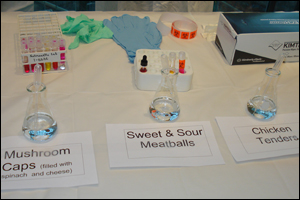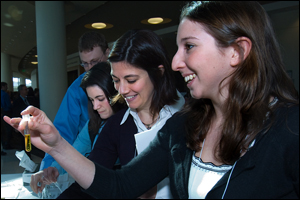CDC In the News
Vet Day Aims to Spark Interest in Public Health Careers
Published: March 4, 2008

Veterinary students participate in talks about outbreak investigations led by CDC and state veterinarians
More than 350 veterinary students and faculty came to the Centers for Disease Control and Prevention (CDC) in Atlanta recently to participate in the second annual "Day at CDC for Veterinary Students." This day was designed to introduce students to the CDC mission of public health and epidemiology and to encourage students to consider public health as a career source.
With approximately 90,000 veterinarians in the United States, only 2.5 percent are in the public sector and the number of veterinarians entering public practice is not keeping up with future needs. So, a team of veterinarians at CDC decided to take action. "We are very hopeful that our efforts for Veterinary Student Day will result in a large payoff in a few years as students who attended find their interests sparked and move into careers in public health," explains Dr. Jennifer McQuiston a veterinary epidemiologist for CDC and co-planner of the event.
In the past several years, veterinarians have played an increasingly critical and diverse role at CDC and in public health, partly because of the increase of zoonotic diseases – diseases of animals that can be transmitted to humans – in the United States and around the world.

A few of the possible sources of contamination used during the exercise
Because 75 percent of all new diseases that affect humans come from animals, animal-borne diseases show no sign of abating; this makes the involvement of veterinarians in public health crucial. Ever since Louis Pasteur first tested his rabies vaccine in 1885, scientists have worked to battle animal-borne diseases such as avian influenza, monkeypox and SARS.
The buzz at the CDC Veterinary Student Day was the simulation exercise, a case control study in which some students became "ill" after eating spinach appetizers at the previous evening's reception. This formed the basis to study interagency cooperation to determine the cause of this "outbreak". Students had to recall foods eaten during the reception the previous evening, select from a list of the food items, and using a test tube with color change array, identify the tube as either a "case" or a "control". It took over 50 CDC staff helpers to pull off the simulation. The highlight of the case study was a taped mock press conference with CDC Director, Julie Gerberding, MD, MPH, used to demonstrate CDC's communication response during an outbreak.

Veterinary students get hands on during the Lunch & Learn exhibit session with CDC, USDA, FDA, and state public health programs.
There are approximately 12,000 veterinary medical students in the today's educational pipeline. If CDC can connect with even a small percentage of these students by demonstrating how we respond to an emerging infectious disease and work with other agencies, this will substantially raise their awareness that a career in public health is exciting, attainable and will ultimately benefit human and animal health, according to McQuiston.
CDC's 90 veterinarians (less than one percent of the Agency's workforce) work in a wide range of areas from bioterrorism to environmental health, food safety, new drug development, occupational safety and health, vectorborne, viral, bacterial diseases, global health, and the health and welfare of animals used in the research laboratories. Because of their broad-based clinical training strongly rooted in preventive medicine, veterinarians are invaluable to the practice of public health.
CDC's Veterinary Student Day was co-sponsored by the Association of American Veterinary Medical Colleges, Department of Homeland Security, American Veterinary Medical Association, National Association of State Public Health Veterinarians, and the American College of Veterinary Preventive Medicine.
Page last updated: March 10, 2008
Content source: Centers for Disease Control and Prevention
Content owner: National Center for Health Marketing
URL for this page: www.cdc.gov/news/2008/03/vetday.html
